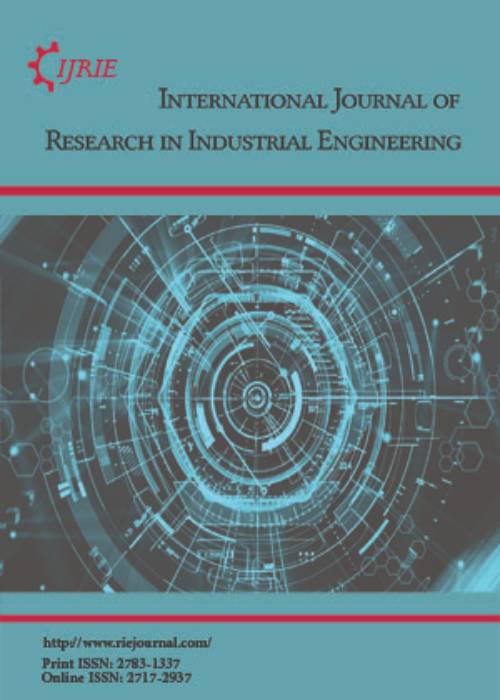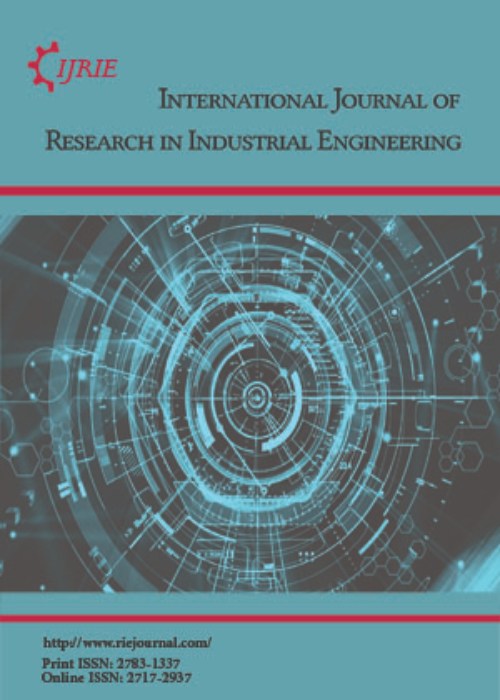فهرست مطالب

International Journal of Research in Industrial Engineering
Volume:12 Issue: 2, Spring 2023
- تاریخ انتشار: 1402/04/19
- تعداد عناوین: 7
-
-
Pages 106-128In recent years, responsiveness in the Supply Chain Network (SCN) has been considered to improve competitiveness because customers are the most significant part of a supply chain, and promptly meeting customer demand is substantial. In this article, to deal with the technological risks, the Reinforcement Policy (RP) before the disruption and the Assets-Sharing (AS) policy before and after the disruption has been used as Resilience Policies for Disruption (RPD). Also, the responsiveness of the network, as well as the risks associated with AS, have been considered in mathematical modeling. In addition, Lateral Sending (LS), delivery time deviations, and penalties for lost sales for increasing customer satisfaction in the cost objective function are considered responsiveness policies. A solution method has been developed based on the augmented ɛ-constraint to solve the model. Finally, the results show an improvement in cost by up to 14% and responsiveness by up to 17% by using the proposed policies, as well as the effectiveness of the developed technique to cope with the Multi-Objective (MO) model.Keywords: Aghezzaf’s method, Supply chain, augmented ɛ-constraint, Responsiveness policies, Delivery Time
-
Pages 129-142
SMEs is one of the pillars that can improve people's lives and is very meaningful for the government. In order for SMEs to continue to develop, even increase, it is necessary to measure service quality and customer satisfaction so that SMEs can identify weaknesses in their business as evaluation material. The research method begins by reviewing the literature related to the SMEs service industry, classifying, choosing what is appropriate for this research. The results of the research show that several methods can be used to measure, analyze, evaluate, and develop products. The KANO method with functional dysfunction assessment to identify customer desires based on attributes can have a significant influence on customer satisfaction. Servqual with a 5 gap analysis model for customer satisfaction analysis, IPA can be used to measure, test, analyze and determine service priority improvements, while QFD is broader. In addition to evaluating the quality of services and products, it is also for development or innovation and is not limited to the service industry but can be used to develop products for the manufacturing industry. Every business needs to be evaluated to improve performance, several approaches such as KANO, Servqual, IPA, QFD can be used as a reference for measuring, evaluating and developing to continue to improve and develop the business.
Keywords: SMEs, Kano, Servqual, IPA, QFD, Quality Service -
Pages 143-154Cooling refrigeration systems ingest prime energy and contribute to universal negative impact due to ecologically unfavorable working fluids used. Hence, the quest to improve the performance of Vapour Compression Refrigeration System (VCRS) with more efficient and eco-friendly refrigerant such as nanoparticles becomes imperative. In this study, performance analysis of hybrid nanofluids-zeotropic mixtures in a VCRS were experimentally investigated to determine the best operating optimum performance using exergy based approach. To achieve this, varying concentrated mixtures were selected using ternary graph. The results revealed that all the designated ratios of the mixed refrigerant with different fractions achieved good performance improvement with optimum values obtained at (011) zero gram of TiO2, 7.5g-Al2O3/CuO. All the selected hybrid mixtures led to an improved outcome in terms of Coefficient of Performance (COP), less power consumption and high performance exergetic efficiency, with COP values ranging from 0.31% to 3.10% and exergetic efficiency from 0.32 to 1.43%. The value for thermal conductivity, dynamic viscosity, density and specific heat were found to be highest (0.0958 W/m.K; 0.00164 W/m.K; 686.82 kg/m3 and 359.82 kJ/kg.K) at the same concentration of zero grams TiO2 in the mixture. Comparison made from the performance characteristics curve (with global parameters) indicated that maximum power coefficient and cooling capacity for the various concentrations were found at (001) 7.5g-TiO2, zero grams Al2O3/CuO equal to 2.2 kW, and the minimum value at concentration of 5 was 0.61% at (111) 5g-TiO2/Al2O3/CuO, and 0.87% for (121). An increase was observed in the maximum power coefficient, cooling capacity and COP increased by 13.51%, 5.78% and 10.33%. It was also observed that hybrid nanofluid-zeotropic refrigerant worked seamlessly with VRCS, making it a sustainable, green and clean as well as eco-friendly alternative with near-zero to zero negative effects on public health safety and environment.Keywords: Nanofluids, Heat Transfer Coefficient, COP, Exergy efficiency, exergy destruction
-
Pages 155-164Multiple Criteria Decision Making (MCDM) methods are used widely by researchers to make decisions in the presence of numerous criteria. It is essential to make the right decision for the most of engineering applications which makes the decision-making process more complex and requires further analysis. A major issue of MCDM methods that they suffer from the Rank Reversal Phenomenon (RRP). Another drawback to MCDM methods that they produce different ranking when evaluating the same problem. Thus, researcher tend to develop new methods to overcome these problems. This paper explores the applicability of a new MCDM approach namely Measurement Alternatives and Ranking according to Compromise Solution (MARCOS) by solving four different engineering problems. The results of MARCOS method are analyzed throughout a comparison with the results of other MCDM methods. The rank reversal test is explored for each problem to check the robustness of the method. The two phases of analysis indicate that the method is robust and applicable for different types of engineering applications.Keywords: Multiple Criteria Decision Making, Rank reversal phenomenon, Measurement alternatives, ranking according to compromise solution method, comparative study
-
Pages 165-176Network DEA models deal with measurements of relative efficiency of Decision-Making Units (DMUs) when the insight of their internal structures is available. In network models, sub-processes are connected by links or intermediate products. Links have the dual role of output from one division or sub-process and input to another one. Therefore, improving the efficiency score of one division by increasing its output may reduce the score of another division because of increasing its input. To address this conflict, in the present paper we proposed a new approach in Slack-Based Measure (SBM) framework which provides deeper insights regarding the sources of inefficiency. The proposed approach is a two-phase procedure in which Phase-I determine the role of intermediate measures by solving a linear program and partitions the intermediate measures into three groups of “input type”, “output type” and “fixed-flows” and Phase-II measures the scores of the DMUs under evaluation. Providing a classification for intermediate products and account their excesses or shortfalls in efficiency calculation while the continuity of link flows between subunits are kept, are the advantages of the proposed approach.Keywords: Network DEA, Intermediate product, SBM, Efficiency score
-
Pages 177-196All organizations inevitably must deal with various critical situations. This requires providing the necessary resilience-building infrastructure and facilities. A review of the research literature reveals that scholars have examined factors affecting Organizational Resilience (OR) from different perspectives. This paper aims to compile and synthesize qualitative findings of previous research to gain an in-depth understanding and provide a list of effacing factors to organizations on their improvement practices related to OR. In conducting a systematic literature review, 98 articles were selected for final analysis. The data were analyzed, summarized, and synthesized in a step-by-step coding process, where 14 themes were identified as factors influencing OR. The identified factors included flexibility, control, redundancy and resources, planning and preparedness, decision-making, social capital, resilience policymaking, organizational culture, staff, financial and economic viability, collaboration, customers and markets, modernization discourse, and learning. Through a meta-synthesis of qualitative findings, this study is one of the first to form a novel perspective for offering a holistic understanding of affecting factors that provide evidence to support improvement practices in OR.Keywords: Resilience, Organizational Resilience, Meta-Synthesis, Effective Factors, qualitative research
-
Pages 197-204Feature selection is the process of picking the most effective feature among a considerable number of features in the dataset. However, choosing the best subset that gives a higher performance in classification is challenging. This study constructed and validated multiple metaheuristic algorithms to optimize Machine Learning (ML) models in diagnosing Alzheimer’s. This study aims to classify Cognitively Normal (CN), Mild Cognitive Impairment (MCI), and Alzheimer’s by selecting the best features. The features include Freesurfer features extracted from Magnetic Resonance Imaging (MRI) images and clinical data. We have used well-known ML algorithms for classifying, and after that, we used multiple metaheuristic methods for feature selection and optimizing the objective function of the classification. We considered the objective function a macro-average F1 score because of the imbalanced data. Our procedure not only reduces the irreverent features but also increases the classification performance. Results showed that metaheuristic algorithms could improve the performance of ML methods in diagnosing Alzheimer’s by 20%. We found that classification performance can be significantly enhanced by using appropriate metaheuristic algorithms. Metaheuristic algorithms can help find the best features for medical classification problems, especially Alzheimer’s.Keywords: Metaheuristic Algorithm, Alzheimer’s disease, MRI, Machine Learning, Feature selection, Data mining


